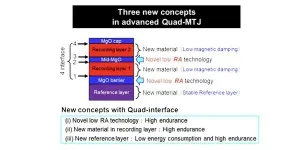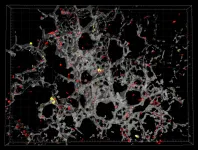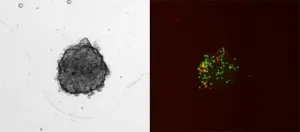(Press-News.org) A new study led by researchers at Washington State University has identified a protein that could be the key to improving treatment outcomes after a heart attack.
Published in the Journal of Biological Chemistry, the research suggests that protein kinase A (PKA) plays a role in heart muscle cell necrosis, a major type of cell death that commonly occurs after reperfusion therapy, the treatment used to unblock arteries and restore blood flow after a heart attack.
"Our study has found that turning off a gene that controls this protein activity increased necrotic cell death and led to more heart injury and worse heart function following heart attack in a rodent model," said study author Zhaokang Cheng, an assistant professor in the WSU College of Pharmacy and Pharmaceutical Sciences. "With further research, this discovery could ultimately lead to the development of a small-molecule drug that could intervene in that pathway to limit or prevent heart muscle cell death after reperfusion therapy."
Such a drug could help reduce heart injury and increase the survival and lifespan of heart attack victims, Cheng said. Every year, about 800,000 people in the U.S. have a heart attack, which amounts to one heart attack occurring every 40 seconds.
Reperfusion therapy, which uses clot-dissolving drugs or mechanical means to unblock clogged arteries, has long been the most effective treatment for heart attack. Though it significantly reduces heart damage, patients treated with this therapy still experience some damage, about half of which actually results from the treatment itself. This is because the rapid restoration of blood flow into oxygen-deprived heart tissues can lead to a swift rise in free radicals. When left unchecked, this surge of free radicals induces oxidative stress, which can cause heart muscle cell death and heart injury as part of a condition known as ischemia/reperfusion injury.
Though scientists have long considered necrosis to be a passive, unavoidable form of cell death, recent studies have suggested that some forms of it happen in a highly regulated manner that could potentially be targeted for treatment. Little has been known about how this type of cell death is regulated, however, which is what prompted Cheng to take a closer look.
He and his team had previously screened more than 20,000 genes to look for ones that appeared to either suppress or promote necrotic cell death. One gene that stood out to them as warranting further study was PRKAR1A, which helps regulate PKA activity by encoding a protein known as PKA regulatory subunit R1alpha.
So the researchers conducted a series of experiments to validate whether the R1alpha protein can regulate necrotic cell death in a rodent model. They found that turning off the PRKAR1A gene increased cell death, both in cultured cells and in mice. Mice lacking the gene also had more heart injury and worse heart function after heart attack, as compared to wild-type mice.
Cheng explained that, under normal circumstances, the rapid increase of free radicals after heart attack treatment triggers the heart to launch its antioxidant defense system, the built-in protective mechanism that helps keep free radicals in check. What their new study findings suggest is that the antioxidant defense system cannot be launched as effectively when the R1alpha protein is removed from the heart, resulting in more oxidative stress, which leads to cell death and heart injury.
He explained that the R1alpha protein binds to another type of protein known as PKA catalytic subunits to keep PKA activity in check. When R1alpha is removed, the catalytic subunits are uncontrolled and PKA activity increases, which Cheng believes is what prevents the activation of the antioxidant defense system. This suggests that use of a small-molecule compound that selectively inhibits PKA activity could potentially block necrotic cell death and lead to better outcomes after heart attack treatment.
Though Cheng said he hoped their research would eventually allow them to test such a compound in an animal model, the next step they are pursuing is to determine whether there are other mechanisms by which PKA regulates necrotic cell death aside from the antioxidant defense system.
INFORMATION:
In addition to Cheng, study authors included Cheng's Ph.D. student Yuening Liu and postdoctoral fellows Jingrui Chen and Peng Xia of the WSU College of Pharmacy and Pharmaceutical Sciences and Constantine Stratakis of the Section on Endocrinology and Genetics at the Eunice Kennedy Shriver National Institute of Child Health and Human Development.
Funding for the study came from the National Heart, Lung, and Blood Institute; the WSU College of Pharmacy and Pharmaceutical Sciences, and the intramural program of the Eunice Kennedy Shriver National Institute of Child Health and Human Development.
As early as the Neolithic period (circa 3900 BC), the domestication of animals likely led to the development of diseases including measles and smallpox. Since then, zoonotic disease has led to other major transnational outbreaks including HIV, Ebola, SARS, MERS, and H1N1 swine flu, among others. Currently, more than half of all existing human pathogens, and almost three-quarters of emerging infectious diseases, are zoonotic in nature.
COVID-19 is the latest and most impactful zoonotic event of the modern era, but it will certainly not be the last.
Given the breadth of these impacts and the fact that other zoonotic pandemics are highly likely - a matter of when and not if - the key public health ethics question that emerges is about whether it is ethically appropriate for governments ...
Doctors have hoped that antibiotics could benefit patients with chronic lung diseases, but a new study has found no benefit for patients with life-threatening idiopathic pulmonary fibrosis in preventing hospitalization or death.
While there were no statistical benefits for patients with the lung-scarring disease, the new research will prevent unnecessary antibiotic use that could contribute to the growing problem of antibiotic resistance. The nationwide clinical trial - believed to be the largest idiopathic pulmonary fibrosis trial ever conducted - also collected biological samples that will advance the understanding and treatment of the mysterious and ultimately fatal illness.
"We were certainly disappointed in the results. But we remain hopeful that in further downstream ...
(Carlisle, Pa.) -- A new study published in the American Journal of Lifestyle Medicine finds critical links between job loss and physical inactivity in young adults during the U.S. Great Recession of 2008-09 that can be crucial to understanding the role of adverse economic shocks on physical activity during the COVID-19 pandemic. It is the first study to examine how job losses during the Great Recession affected the physical activity of young adults in the United States.
The study by Dickinson College economist Shamma Alam and Harvard T. H. Chan School of Public Health economist Bijetri Bose looked at Panel Study of Income Dynamics (PSID) data for young adults age 18 to 27--a phase of development associated with maturation and significant ...
Professor Tetsuo Endoh's Group at Tohoku University's Center for Innovative Integrated Electronics has announced a new magnetic tunnel junction (MTJ) quad-technology that provides better endurance and reliable data retention - over 10 years - beyond the 1X nm generation.
This novel Quad technology meets the design requirements for the state-of-the-art X nm complementary metal-oxide semiconductor (CMOS) node and will pave the way for ultra-low-power consumption for Internet of Things (IoT) edge-devices in mobile communication, the automotive industry, consumer electronics, ...
Researchers from Telethon Kids Institute and Curtin University in Perth and Tulane University in New Orleans have developed sophisticated data modelling that could help eradicate malaria in Haiti.
Haiti is the poorest country in the Caribbean - beset by natural disasters - and is one of the few countries in the region that have not mostly wiped out the mosquito-borne disease.
Telethon Kids Institute researcher Associate Professor Ewan Cameron led the team, using a range of different health data to create a complete picture of where malaria infections are taking place in Haiti. This information has been used to directly inform Haiti's national response to malaria.
The team's findings ...
Treating patients with acute respiratory failure is a constant challenge in intensive care medicine. In most cases, the underlying cause is lung inflammation triggered by a bacterial infection or - more rarely, despite being frequently observed at present due to the corona pandemic - a viral infection. During the inflammation, cells of the immune system - the white blood cells - migrate to the lungs and fight the pathogens. At the same time, however, they also cause "collateral damage" in the lung tissue. If the inflammatory reaction is not resolved in time, this can result in chronic inflammation with permanent impairment of lung function. Together with colleagues from London, Madrid and Munich, a research team at the University ...
Researchers at the University of Eastern Finland have uncovered potential mechanisms by which microRNAs (miRNA) drive atherogenesis in a cell-type-specific manner. Published in the Arteriosclerosis, Thrombosis, and Vascular Biology journal, the study provides novel insight into the miRNA profiles of the main cell types involved in atherosclerosis.
Atherosclerosis is the underlying cause of most cardiovascular diseases and one of the leading causes of mortality in the world. During atherosclerosis, arteries become progressively narrow and thick due to the formation of plaques containing cholesterol deposits, calcium and cells, among other components. ...
Every tumour is different, every patient is different. So how do we know which treatment will work best for the patient and eradicate the cancer? In order to offer a personalised treatment that best suits the case being treated, a team of scientists led by the University of Geneva (UNIGE), Switzerland, had already developed a spheroidal reproduction of tumours that integrates the tumour cells, but also their microenvironment. However, the immune system had not yet been taken into account, even though it can either be strengthened or destroyed by the treatment given to the patient. Today, the Geneva team has succeeded in integrating two types of immune cells that come directly from the patient into the spheroidal structure, ...
The Permian Basin, located in western Texas and southeastern New Mexico, is the largest oil- and gas-producing region in the U.S. The oilfield operations emit methane, but quantifying the greenhouse gas is difficult because of the large area and the fact that many sources are intermittent emitters. Now, researchers reporting in ACS' Environmental Science & Technology Letters have conducted an extensive airborne campaign with imaging spectrometers and identified large methane sources across this area.
According to the U.S. Energy Information Administration, 38% of the nation's total oil and 17% of natural gas production took place in the Permian Basin in 2020. Therefore, quantifying emissions from these operations, which continue to expand rapidly, is ...
A healthy diet around the time of conception through the second trimester may reduce the risk of several common pregnancy complications, suggests a study by researchers at the National Institutes of Health. Expectant women in the study who scored high on any of three measures of healthy eating had lower risks for gestational diabetes, pregnancy-related blood pressure disorders and preterm birth. The study was conducted by Cuilin Zhang, M.D., Ph.D., and colleagues at NIH's Eunice Kennedy Shriver National Institute of Child Health and Human Development (NICHD). It appears in the American Journal of Clinical Nutrition. ...








